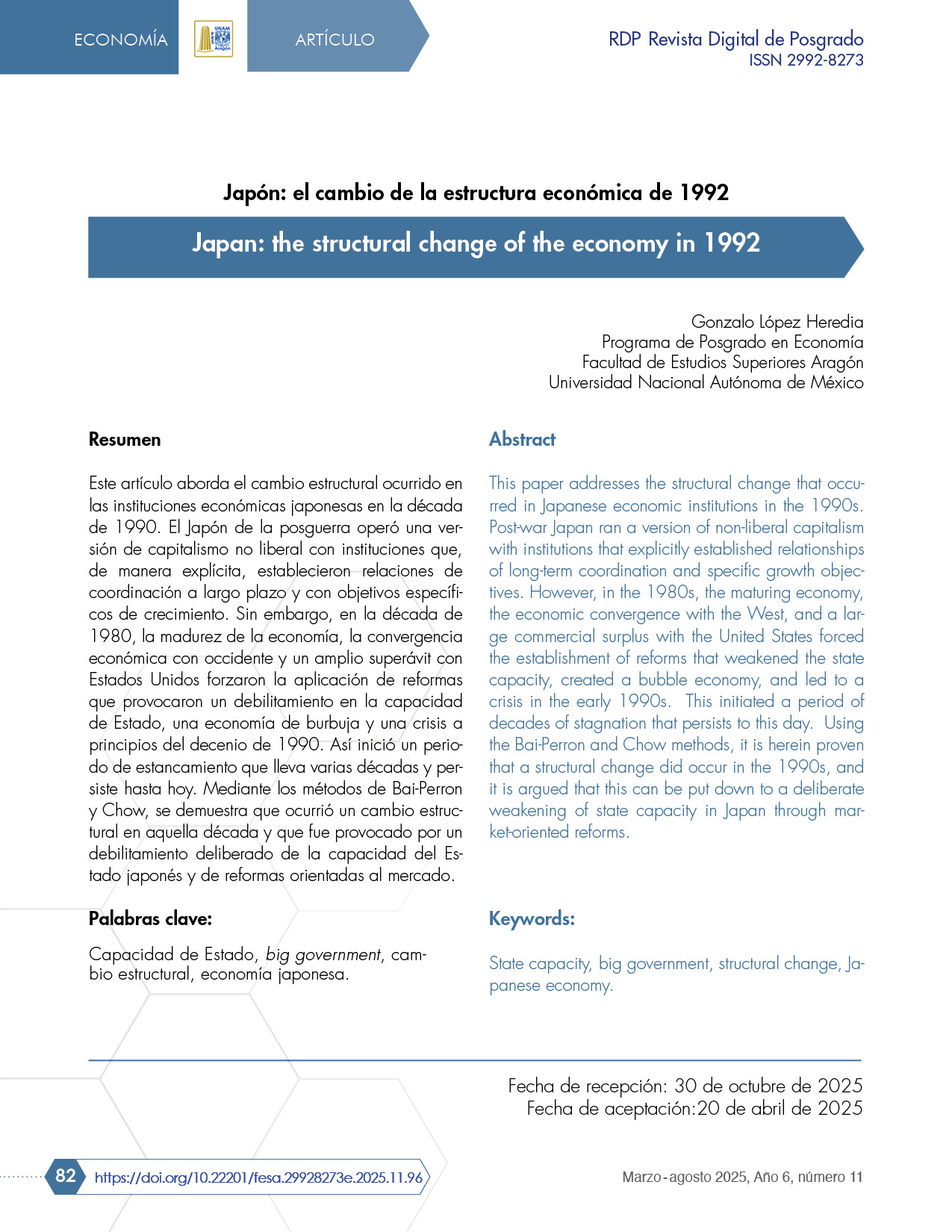Japón: el cambio de la estructura económica de 1992
DOI:
https://doi.org/10.22201/fesa.29928273e.2025.11.96Palabras clave:
Capacidad de Estado, big government, cambio estructural, economía japonesa.Resumen
Este artículo aborda el cambio estructural ocurrido en las instituciones económicas japonesas en la década de 1990. El Japón de la posguerra operó una versión de capitalismo no liberal con instituciones que, de manera explícita, establecieron relaciones de coordinación a largo plazo y con objetivos específicos de crecimiento. Sin embargo, en la década de 1980, la madurez de la economía, la convergencia económica con occidente y un amplio superávit con Estados Unidos forzaron la aplicación de reformas que provocaron un debilitamiento en la capacidad de Estado, una economía de burbuja y una crisis a principios del decenio de 1990. Así inició un periodo de estancamiento que lleva varias décadas y persiste hasta hoy. Mediante los métodos de Bai-Perron y Chow, se demuestra que ocurrió un cambio estructural en aquella década y que fue provocado por un debilitamiento deliberado de la capacidad del Estado japonés y de reformas orientadas al mercado.
Citas
Bai, J. (1997). Estimating Multiple Breaks One at a Time. Econometric Theory, 13, 315–352.
Bai, J. & Perron, P. (2003). Computation and Analysis of Multiple Structural Change Models. Journal of Applied Econometrics, 6, 72–78.
Brown, R.L., Durbin, J. & Evans, J.M. (1975). Techniques for testing the constancy of regression relationships over time. Journal of the Royal Statistical Society, Series B, 149-162.
Cargill, T. F., Hutchison, M. M. & Ito, T. (2003). The political economy of Japanese monetary policy. MIT Press.
Chow, G. C. (1960). Tests of equality between sets of coefficients in two linear regressions. Econometrica: Journal of the Econometric Society, 591-605.
Eviews (s. f.). Multiple Breakpoint Testing in EViews 8. t.ly/-Vwcv.
Federal Reserve Economic Data (FRED). (2021, 8 de noviembre). Real GDP at Constant National Prices for Japan. Serie RGDPNAJPA666NRUG. Federal Reserve Bank of St. Louis. t.ly/dqXY3
Federal Reserve Economic Data (FRED). (s. f.). M1 for Japan. Serie MYAGM1JPM189N. Federal Reserve Bank of St. Louis. t.ly/xy6zX
Ginsburg, T. (2001). Dismantling the developmental state-administrative procedure reform in Japan and Korea. American Journal of Comparative Law, 49(4), 585.
Ginsburg, T. (2002). System Change? A New Perspective on Japan’s Administrative Procedure Law. Zeitschrift für japanisches Recht, 7(13), 55-84.
Higashi, C. & Lauter, P. G. (2012). The internationalization of the Japanese economy. Springer Science & Business Media.
Hoshi, T. (2002). The convoy system for insolvent banks: how it originally worked and why it failed in the 1990s. Japan and the World Economy, 14(2), 155-180.
Minsky, H. P. (2008). Stabilizing an unstable economy. McGraw-Hill.
Nishijima, S. (2012). Japanese industrial policy. Perspective of the World, 4-3.
Ohno, K. (2006). The history of Japanese economic development: The Path Traveled by Japan as a Developing Country. GRIPS Development Forum.
Ohno, K. (2018). The history of Japanese economic development: Origins of private dynamism and policy competence. Taylor & Francis.
Okazaki, T. (2017). Industrial Policy in Japan: 70-Year History since World War II. Economy, Culture & History Japan Spotlight Bimonthly.
Ozaki, R. S. (1970). Japanese views on industrial organization. Asian Survey, 10(10), 872-889.
Quandt, R. E. (1960). Tests of the hypothesis that a linear regression system obeys two separate regimes. Journal of the American statistical Association, 55(290), 324-330.
Streeck, W. & Yamamura, K. (2003). Introduction: Convergence or diversity? Stability and change in German and Japanese capitalism. En W. Streeck, & K. Yamamura (Eds.), The end of diversity: Prospects for German and Japanese capitalism. Ithaca.
Tiberghien, Y. (2011). Thirty years of neo-liberal reforms in Japan. In S. Lechevalier (Ed.), The great transformation of Japanese capitalism. Routledge.
Vogel, S., K. (1996). Freer Markets, More Rules: Regulatory Reform in Advanced Industrial Countries. Ithaca; Cornell University Press.
Weiss, L. (1998). The myth of the powerless state. Cornell University Press.
World Bank Group. (s. f.). Inflación, precios al consumidor (porcentaje anual)-Japón. https://data.worldbank.org/indicator/FP.CPI.TOTL.ZG?locations=JP

Descargas
Publicado
Cómo citar
Número
Sección
Licencia
Derechos de autor 2025 Universidad Nacional Autónoma de México

Esta obra está bajo una licencia internacional Creative Commons Atribución-NoComercial-SinDerivadas 4.0.




